
The Uncomfortable Truth About Foam Wrist Rests: Why Cork Is King
Share
Let's talk about that squishy foam wrist rest that's been sitting on your desk. You know, the one that started out plump and supportive but now looks like it's been through a marathon of all-nighters. There's a reason it's looking sad, and it's time we had an honest conversation about why cork is the superior choice for your weary wrists.
Remember when your foam rest was new? That cushy, cloud-like feeling that made you think you'd found the perfect typing companion? Unfortunately, like a relationship built on shallow promises, foam doesn't age well. Over time, those synthetic materials break down, compress, and lose their supportive qualities faster than you can say "repetitive strain injury."
Aging with Grace
Cork, on the other hand, is like that friend who gets better with age. Its natural cellular structure – millions of tiny air pockets – provides consistent support that maintains its integrity over time. Unlike foam, which eventually develops permanent depressions where your wrists rest, cork gently adapts while maintaining its fundamental structure. It's like memory foam, but without the memory loss.
Chemical Free
Let's talk chemicals for a moment. That foam rest? It's essentially a cocktail of synthetic materials and volatile organic compounds (VOCs) sitting right under your wrists. Cork keeps it clean and natural – it's just tree bark that's been carefully processed. No off-gassing, no questionable materials, just pure, natural comfort that you can feel good about.
Naturally Antimicrobial
Here's another uncomfortable truth about foam: it's a dust and bacteria magnet. Those tiny pores in foam collect dirt, skin cells, and moisture, creating a not-so-clean surface that gets increasingly grimy over time. Cork, with its natural antimicrobial properties, resists bacteria and is easily wiped clean. It's like having a self-cleaning wrist rest (though you should still give it a wipe now and then).
Temperature regulation is where cork really shows off. While foam can feel clammy in summer and cold in winter, cork maintains a remarkably consistent feel regardless of the season. It's like having climate control for your wrists, courtesy of Mother Nature herself.
Sustainability
And let's not forget about sustainability. While foam wrist rests eventually end up in landfills, where they'll outlast your great-grandchildren's great-grandchildren, cork is completely renewable and biodegradable. The cork oak trees it comes from live for centuries, producing cork bark every nine years without ever being cut down. It's the gift that keeps on giving, unlike foam's gift that keeps on existing in a landfill somewhere.
The Bottom Line
Your wrists deserve better than a temporary relationship with foam. They deserve the natural, lasting support of cork – a material that, like a fine wine or a good friendship, only gets better with time. Make the switch, and your wrists will thank you. Your conscience will too.
And hey, when was the last time you heard someone compare their foam wrist rest to a Birkenstock? Exactly. There's a reason for that.
